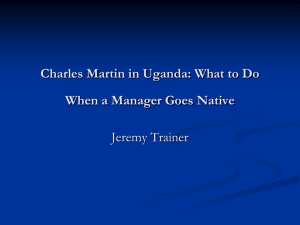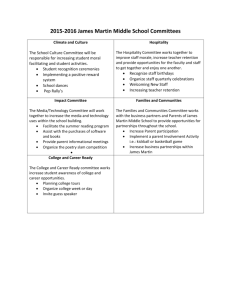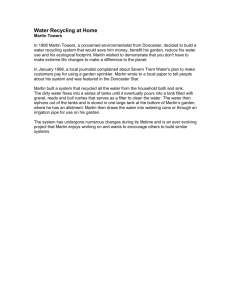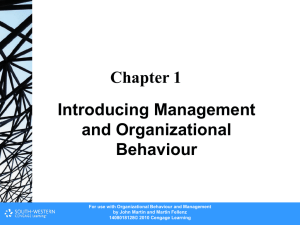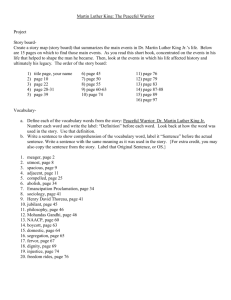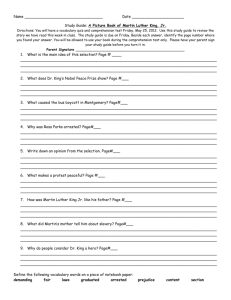Chapter 7
advertisement
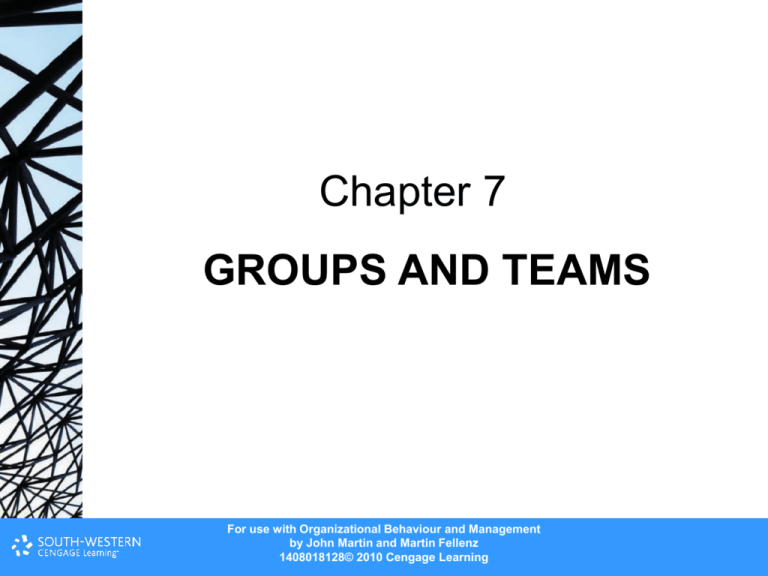
Chapter 7 GROUPS AND TEAMS For use with Organizational Behaviour and Management by John Martin and Martin Fellenz 1408018128© 2010 Cengage Learning Definition of a group • Various definitions but all imply: More than one person involved Interaction must take place Purpose or intention Awareness For use with Organizational Behaviour and Management by John Martin and Martin Fellenz 1408018128© 2010 Cengage Learning Groups Groups - social entities of two or more people who interact with each other, are psychologically aware of each other, and think of themselves as a group Formal groups are typically set up and sanctioned by the organization, and thus have specific objectives that contribute to achieving organizational goals Informal groups are groups that form through interactions among organizational members For use with Organizational Behaviour and Management by John Martin and Martin Fellenz 1408018128© 2010 Cengage Learning Groups and teams • Katenbach & Smith suggest that difference between group and team is that of performance and describe the following scale: – Working group – Pseudo-teams – Potential teams – Real teams – High performance teams For use with Organizational Behaviour and Management by John Martin and Martin Fellenz 1408018128© 2010 Cengage Learning Groups, teams and organizations Hierarchical differentiation Specialism groupings Activity groupings Boundary spanning Professional For use with Organizational Behaviour and Management by John Martin and Martin Fellenz 1408018128© 2010 Cengage Learning Likert’s linking pin model Figure 7.1 For use with Organizational Behaviour and Management by John Martin and Martin Fellenz 1408018128© 2010 Cengage Learning The hierarchy/customer conflict model Figure 7.2 For use with Organizational Behaviour and Management by John Martin and Martin Fellenz 1408018128© 2010 Cengage Learning WHY DO ORGANIZATIONS USE GROUPS? • Synergy • Social control • Social facilitation • Potential problems include: • Social inhibition • Social loafing • Sucker effect For use with Organizational Behaviour and Management by John Martin and Martin Fellenz 1408018128© 2010 Cengage Learning Cultural and other factors in informal group formation • The need for human beings to function in a social environment and to form relationships of their own choosing • The voluntary nature of many informal groups offsets the involuntary nature of many formal, organizational groups • The approach adopted by managers to the running of the organization • The need for individuals to exert influence and to achieve their formal and personal goals For use with Organizational Behaviour and Management by John Martin and Martin Fellenz 1408018128© 2010 Cengage Learning Tuckman and Jensen’s model of group development Stage 1 – Forming Stage 2 – Storming Stage 3 – Norming Stage 4 – Performing Stage 5 - Adjourning For use with Organizational Behaviour and Management by John Martin and Martin Fellenz 1408018128© 2010 Cengage Learning Issues associated with Tuckman’s first four stages of group development • Figure 7.3 For use with Organizational Behaviour and Management by John Martin and Martin Fellenz 1408018128© 2010 Cengage Learning Recent group development model Based on: Gibson & Earley, 2007; Gibson et al., 2009: •information accumulation (perception and storing of information) •interaction (retrieving, exchanging, and interactively structuring information) •examination (meaning is socially negotiated and evaluated) •accommodation (members integrate information, make decisions and take action) For use with Organizational Behaviour and Management by John Martin and Martin Fellenz 1408018128© 2010 Cengage Learning Communication patterns in groups • Figure 7.4 For use with Organizational Behaviour and Management by John Martin and Martin Fellenz 1408018128© 2010 Cengage Learning • • • • • • • • • The nine Belbin team roles Plant: Creative, imaginative, unorthodox. Solves difficult problems Resource investigator: Extrovert, enthusiastic, communicative. Explores opportunities. Develops contacts Co-ordinator: Mature, confident, a good chairperson. Clarifies goals, promotes decision making, delegates well Shaper: Challenging, dynamic, thrives on pressure. Has the drive and courage to overcome obstacles Monitor/evaluator: Sober, strategic and discerning. Sees all options. Judges accurately Teamworker: Co-operative, mild, perceptive and diplomatic. Listens, builds, averts friction, calms the waters Implementer: Disciplined, reliable, conservative and efficient. Turns ideas into practical actions Completer: Painstaking, conscientious, anxious. Searches out errors and omissions. Delivers on time Specialist: Single-minded, self-starting, dedicated. Provides knowledge and skills in rare supply. For use with Organizational Behaviour and Management by John Martin and Martin Fellenz 1408018128© 2010 Cengage Learning Features of effective and ineffective groups Dimension 1 Atmosphere Effective group Informal, comfortable, relaxed Participative, pertinent to task 2 Discussion 3 Objectives 4 Active listening 5 Disagreement 6 Decision making By consensus 7 Criticism Frank but not personal 8 Feelings 9 Action Expressed on group activity as well as ideas. Few hidden agendas Clear allocation and acceptance Not chair dominated, ‘experts’ lead depending on circumstances, no power struggles Self-consciousness about present operations, frequent reviews 10 Leadership 11 Reviews Understood and accepted by all Members listen to each other, contribution to debate and ideas Brought into the open and resolved or accepted Ineffective group Indifference, boredom, tension Dominated by a few people, drifts off point Lack of clarity, not fully accepted by individuals Pushing of own ideas, no evidence of building on others, talking for effect Not resolved, suppressed by leader, perhaps warfare domination is the aim Premature decisions and actions before full examination. Simple majority voting Embarrassing, tension producing. Involves personal hostility, destructive approach Hidden, not thought appropriate to group activity Unclear in allocation, lack of commitment to achieve result Chair dominated No discussion of group maintenance issues For use with Organizational Behaviour and Management by John Martin and Martin Fellenz 1408018128© 2010 Cengage Learning GROUP CONTROL AND ROLE THEORY • Rules - explicit informal agreements or formal statements about acceptable and unacceptable behaviour • Norms - implicit and informal expectations for behaviour within social entities • Expected role – what the organization expects the individual to do in relation to their role • Perceived role – what the individual understands their expected role to be • Enacted role - reflects what the individual actually does in carrying out the tasks for which they are responsible For use with Organizational Behaviour and Management by John Martin and Martin Fellenz 1408018128© 2010 Cengage Learning Manifestation of team processes in action and transition phases • Figure 7.5 For use with Organizational Behaviour and Management by John Martin and Martin Fellenz 1408018128© 2010 Cengage Learning Group process dimensions • Table 7.5 For use with Organizational Behaviour and Management by John Martin and Martin Fellenz 1408018128© 2010 Cengage Learning The components of the role theory Handy (1993) • Role set • Role definition • Role ambiguity •Role incompatibility • Role conflict • Role overload/underload • Role stress For use with Organizational Behaviour and Management by John Martin and Martin Fellenz 1408018128© 2010 Cengage Learning Role set for a university lecturer • Figure 7.6 For use with Organizational Behaviour and Management by John Martin and Martin Fellenz 1408018128© 2010 Cengage Learning GROUP COHESION Factors which contribute to the level of cohesion developed within a group include: •Environmental factors •Organizational factors •Group factors •Individual factors For use with Organizational Behaviour and Management by John Martin and Martin Fellenz 1408018128© 2010 Cengage Learning GROUP COHESION • Figure 7.7 For use with Organizational Behaviour and Management by John Martin and Martin Fellenz 1408018128© 2010 Cengage Learning Relationship between group cohesion and group performance •Figure 7.8 For use with Organizational Behaviour and Management by John Martin and Martin Fellenz 1408018128© 2010 Cengage Learning



